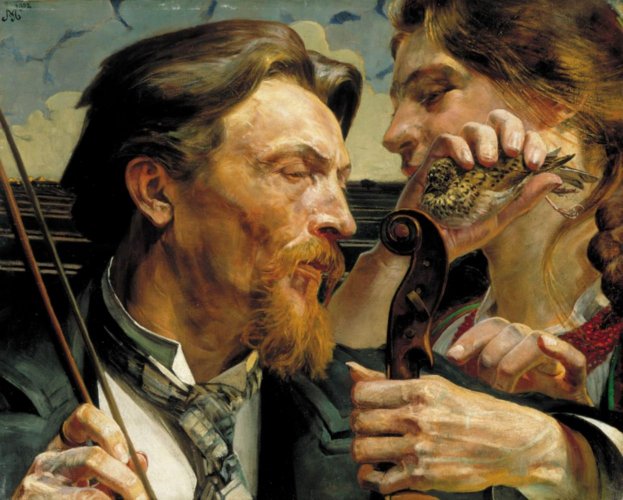Description:
Jack Malczewski (1854-1929) had a passion for art and romantic literature, especially the poetry of Juliusz Słowacki, which he carried from his family home. He was from a szlachecki family, though not wealthy. His father Julian supported him on his path to becoming an artist. The events of 1863, the January uprising and subsequent repressions, left a lasting impression on the young artist. His first teacher was Adolf Dygasiński. He spent his youth from 1867 to 1871 at his uncle Karczewski’s manor in Wielgie. In 1873 he began studying at the School of Fine Arts in Krakow under the tutelage of Jan Matejko. He was a student of Władysław Łuszczkiewicz. He also trained at the École des Beaux-Arts in Paris. He traveled to Italy, Vienna, Munich, Greece, and Asia Minor. From 1896 to 1900 and 1910 to 1914 he was a professor at the Academy of Fine Arts in Krakow. From 1912 to 1914 he was its rector. He started with a form of idealized realism, then went to naturalism, and the main theme of his work during this period was the fate of exiles in Siberia and the inspiration of Juliusz Słowacki’s “Anhellim”. At the same time, fantastic and allegorical elements began to appear in Malczewski’s work. After his father’s death in 1884, the recurring theme in Malczewski’s work was Thanatos, the god of death. After 1890 his art became thoroughly symbolic. Works that manifest this turn towards a style of symbolism include: “Introduction” 1890, “Melancholia” 1890-1894, “Vicious Circle” 1895-1897. The artist addressed existential, historical and artistic topics, intertwining ancient and biblical motifs with native folklore and the Polish landscape so important in his works. Form, color, the monumentality of the representations and their expression became his hallmark.
Description of the painting:
This painting is a characteristically framed portrait. Only the busts of the painted characters are visible, filling the frame of the presentation. A middle-aged man with a beard holds a violin in his left hand. The gesture of slightly raised arm and the bow held in readiness in his right hand indicate that the music is about to start. Standing next to him is a woman in folk costume, with red coral around her neck, holding a small skylark in her hand. She touches the carved head of the violin. The man does not seem to notice it. His thoughtful gaze is directed far beyond the visible scene for us. In the background there is a view of a field adorned with parallel furrows, reminiscent of invisible violin strings or, as some suggest, five-line musical notation.
In this outlined scenery, the skylark becomes a hopeful messenger of spring. It is associated with dawn and a pleasant singing to the ear. According to Slavic beliefs, it was supposed to be inhabited by the souls of the deceased. The Christian tradition compares the constant striving towards the light, purity and divinity with the rising of the sun in the morning. It was believed that the sounds sung by it accompanied the crucified Christ, and the bird itself extracted thorns from Jesus’ wounded head. Thus, the skylark became a symbol of humility and mercy sanctified by the folk tradition. Usually singing in flight, it was supposed to bring happiness and relief.
The figure of the man depicted in the portrait is identified as Antoni Zembaczyński or Ferdynand Olesiński. Both were students of Jan Matejko, artists dealing with religious themes in their work. Interestingly, Malczewski placed a violin in the figure’s hand, not an attribute of a painter, but becoming in this context a symbol of art. Created as a work of human and human skills. The flying skylark sings, praising the awakening day and announcing the rebirth of nature. However, the bird in Jacek Malczewski’s painting does not rise above the horizon. Silent, held in the palm, enslaved. The task of his must be taken over by the artist stepping on the ground. He will now become a link between the divine and human world, heralding rebirth. The author himself has provided the painting with a quotation from the “Song of the Bar Confederates” from Juliusz Słowacki’s drama “Ksiądz Marek”:
“We rose to work with the skylarks
And we’ll sleep at the evening glow.
But in the graveyard we still soldiers
And the army of God […]”.
The task that lies on the artists is thus burdened with responsibility not only towards the people, enslaved still at the time of their homeland, but also towards God.


